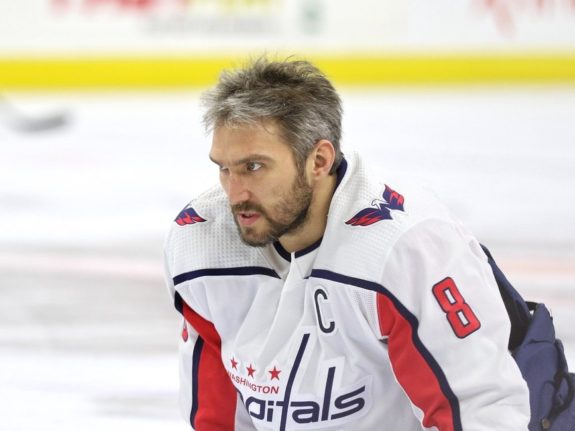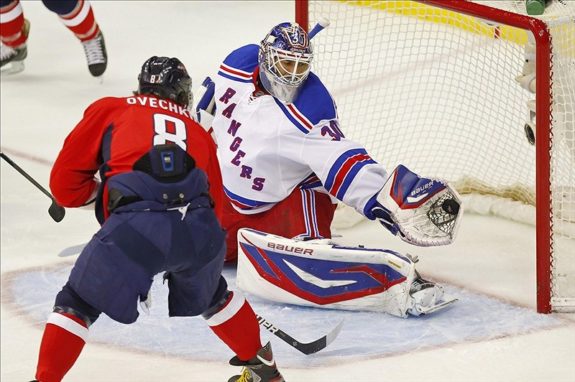The Washington Capitals are aware of the emerging talent in the Metropolitan Division. Since winning the Stanley Cup in 2018, the Capitals are coming off of back-to-back first-round exits courtesy of the Carolina Hurricanes and New York Islanders. The team will yet again be all-in for Lord Stanley’s Cup, with their championship core still intact and their recent free-agent acquisitions. But how do they stack up against the stiff divisional competition?

Here’s a look at how the Caps will lineup against their biggest divisional threats, what they’ve done to improve the roster during the offseason, and what their lineup might look like once play resumes (whenever that might be).
Capitals Divisional Threats
Atop the list of threats is the Pittsburgh Penguins. Despite not making the playoffs for the first time since 2005-06 last season, a consistent Sidney Crosby and company will be in the mix in 2020-21. Trading Matt Murray and adding Kasperi Kapanen has filled some empty holes on the Penguins’ roster, who like the Capitals, are starving for postseason success after poor outings in 2019 and 2020.
Next up we have the New York Islanders, who established themselves as legitimate contenders last postseason with an impressive run to the Eastern Conference Final. After making quick work of the Capitals in the first round before defeating the top-seeded Philadelphia Flyers in the second, Barry head coach Trotz and the Isles will no longer be pushovers in the Metro heading into 2020-21.
As the Eastern Conference’s top-seeded bubble team in 2019-20, the Flyers have something to prove next season. They have found stability in the crease with Carter Hart and look poised to contend for the Metro’s top spot again next season and build on their success.
The Columbus Blue Jackets are another Metropolitan team that can’t be slept on heading into 2020-21. Having made 4 postseason appearances in-a-row under bench boss John Tortorella, the Jackets’ strong defensive corps and steady goaltending will certainly be a tough task for teams to match up against when the season begins.
The Hurricanes, New York Rangers and New Jersey Devils will rely on their young core to carry them through the 2020-21 campaign. While the Hurricanes have shown to be competitive in the last few seasons, the Rangers’ and Devils’ slew of first-overall picks and their eager young players will be looking for breakout seasons in 2020-21. Will the Capitals’ championship core and recent free-agent signings be enough to stay ahead of the pack?
Offseason Improvements
The Capitals kicked off their offseason by signing head coach Peter Laviolette on Sept. 15. He will replace Todd Reirden, who was hired following the departure of Barry Trotz and fired just three days after the Capitals’ first-round elimination.
Laviolette, 55, brings a championship pedigree to the Capitals. He won the Cup with the Hurricanes in 2006 and took both the Flyers (2010) and Nashville Predators (2017) to the Stanley Cup Final. The longstanding NHL head coach also boasts a 637-425-123 record and is ranked 16th all-time in coaching victories.
Henrik Lundqvist was Caps’ GM Brian MacLellan’s first free-agent acquisition of 2020. The veteran netminder and former ‘King of New York’ signed a team-friendly one-year contract worth $1.5 million after perennial starter Braden Holtby signed with the Vancouver Canucks.

Signing Lundqvist provides a cushion for 23-year-old Ilya Samsonov, who will likely transition into the starting role next season with just 26 games of NHL experience. While Samsonov’s career is just beginning, Lundqvist brings with him a 15-year NHL career and 459 career wins – good enough for 6th all-time.
Along with being set in the crease, the Capitals strengthened their blue line by signing Justin Schultz to a two-year, $8 million contract. Following five seasons with the Penguins, the 30-year-old right-handed defenceman is expected to play a top-4 role in Washington. But did MacLellan overpay?
Since his impressive 51-point (12 goals, 39 assists) campaign in 2016-17, Schultz’s career has been plagued by injuries; he’s played a combined 138 games in the last three seasons. In 46 games in 2019-20, he recorded three goals and nine assists. While his points-per-game average ranked 119th among NHL defencemen, his outlet pass success rate was one of the best in the league at 78.9%. Whether or not his style of play will fit into Laviolette’s system is uncertain, but this acquisition is an improvement to the team’s roster, even with the $4 million price tag.
Signing Trevor van Riemsdyk to a one-year, $800,000 contract brings insurance to the Capitals’ back-end, which will need much depth if they plan on making a run for the Cup in 2020-21. While Riemsdyk wasn’t brought on to be a Norris Trophy candidate, his experience and defensive capabilities are exactly what the Capitals need to stay competitive in the Metro.
Capitals’ 2020-21 Lineup
The Capitals’ lineup is ready to compete in 2020-2021. Following the free-agent signings, here is what the lineup could look like when play resumes:
Ovechkin — Kuznetsov — Wilson
Vrana — Backstrom — Oshie
Hagelin — Eller — Panik
Hathaway — Dowd — Pinho/Sprong
Dillon — Carlson
Orlov — Schultz
Siegenthaler — Jensen/van Riemsdyk
Samsonov — Lundqvist
The recent additions to the blue line and in the crease have cemented their depth on the back-end, and with a seasoned forward lineup, the Capitals can afford to leave stud prospects like Connor McMichael in the minors, pending injuries or exceptional play by the young player.
Looking Forward
The Capitals are roughly $1 million over the league’s salary cap limit, meaning that they will likely need to move a contract before 2020-21 kicks off. They will also face many difficult decisions in 2021 when Ovechkin, Jakub Vrana, and Ilya Samsonov will need new contracts with only $16.3 million in projected cap space available. To boot, the Capitals will be forced to let go of a player when the Seattle Kraken draft into the league at the end of next season.
Regardless of any further offseason moves, the Capitals will be in a favourable position to be successful against their Metropolitan opponents again next season. But have they done enough to propel themselves back to the top of the Metro and among the best in the league?